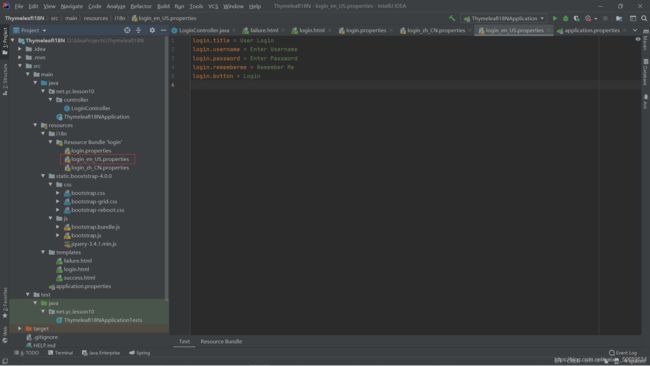Spring Boot学习笔记10——配置国际化页面
文章目录
- 一、使用Thymeleaf配置国际化页面
-
- 1、编写多语言国际化配置文件
-
- (1)在resources下创建i18n目录
- (2)在i18n目录里创建login.properties
- (3)在i18n目录里创建login_zh_CN.properties
- (4)在i18n目录里创建login_en_US.properties
- 2、编写全局配置文件
- 3、定制区域信息解析器
- 4、页面国际化使用
- 5、整合效果测试
- 二、Thymeleaf复杂数据的展示
-
- 1、创建用户实体类
- 2、创建用户控制器
- 3、创建显示全部用户信息模板页面
- 4、修改登录成功模板页面
- 5、启动项目,查看效果
一、使用Thymeleaf配置国际化页面
2、将上一讲ThymeleafDemo项目的内容拷贝到新项目里
1、编写多语言国际化配置文件
(1)在resources下创建i18n目录
(2)在i18n目录里创建login.properties
(3)在i18n目录里创建login_zh_CN.properties
(4)在i18n目录里创建login_en_US.properties
2、编写全局配置文件
打开项目的application.properties全局配置文件,在该文件中添加国际化文件基础名设置
3、定制区域信息解析器
1、使用@Configuration注解成一个配置类
2、重写resolveLocale方法,根据请求参数的值来实例化Locale对象
3、使用@Bean把这个配置类交给Spring容器进行管理
package net.yc.lesson10.resolver;
import org.springframework.context.annotation.Bean;
import org.springframework.context.annotation.Configuration;
import org.springframework.web.servlet.LocaleResolver;
import org.thymeleaf.util.StringUtils;
import javax.servlet.http.HttpServletRequest;
import javax.servlet.http.HttpServletResponse;
import java.util.Locale;
@Configuration
public class MyLocaleResolver implements LocaleResolver {
@Override
public Locale resolveLocale(HttpServletRequest httpServletRequest) {
//获取区域标识
String flag= httpServletRequest.getParameter("flag");
//获取区域对象
Locale locale = Locale.getDefault();
//判断区域标识是否为空
if(StringUtils.isEmpty(flag)){
//对区域标识进行处理
String[] split = flag.split("_");//使用下划线切分出一个数组,如zh_CN,["zh","CN"]
locale = new Locale(split[0], split[1]);
}
return locale;
}
@Override
public void setLocale(HttpServletRequest httpServletRequest, HttpServletResponse httpServletResponse, Locale locale) {
}
@Bean
public LocaleResolver localeResolver() {
return new MyLocaleResolver();
}
}
4、页面国际化使用
用户登录页面login.html结合Thymeleaf模板引擎实现国际化功能

<!DOCTYPE html>
<html lang="en" xmlns:th="http://www.thymeleaf.org/">
<head>
<meta charset="UTF-8">
<title>用户登录</title>
<link th:href="@{/bootstrap-4.0.0/css/bootstrap.css}" rel="stylesheet">
<javascript th:src="@{/bootstrap-4.0.0/js/jquery-3.4.1.min.js}"></javascript>
<javascript th:src="@{/bootstrap-4.0.0/js/bootstrap.bundle.js}"></javascript>
<javascript th:src="@{/bootstrap-4.0.0/js/bootstrap.js}"></javascript>
</head>
<body>
<div class="col-6 m-auto" style="margin-top:30px!important;">
<div class="text-center">
<span th:text="${currentYear}">今年</span> -
<span th:text="${currentYear} + 1">明年</span>
</div>
<div class="border border-info bg-light p-2" style="border-radius: 5px">
<form action="/login" method="post">
<h3 class="text-center" th:text="#{login.title}">用户登录</h3>
<div class="mt-1">
<input type="text" id="username" name="username" class="form-control" th:placeholder="#{login.username}" required
autofocus>
</div>
<div class="mt-1">
<input type="password" id="password" name="password" class="form-control" th:placeholder="#{login.password}" required>
</div>
<div class="checkbox text-center">
<label>
<input class="form-check-input text-center" type="checkbox" id="remember-me">[[#{
login.rememberme}]]
</label>
</div>
<div>
<button class="btn btn-lg btn-primary btn-block" id="login" type="submit" th:text="#{login.button}">登录</button>
</div>
<div class="text-center">
<a class="btn btn-sm" th:href="@{/toLoginPage(flag='zh_CN')}">中文</a>
<a class="btn btn-sm" th:href="@{/toLoginPage(flag='en_US')}">English</a>
</div>
</form>
</div>
</div>
</body>
</html>
5、整合效果测试
二、Thymeleaf复杂数据的展示
1、创建用户实体类
package net.yc.lesson10.bean;
/**
* 功能:用户实体类
*/
public class User {
private Integer id;
private String name;
private String gender;
private Integer age;
public User() {
}
public User(Integer id, String name, String gender, Integer age) {
this.id = id;
this.name = name;
this.gender = gender;
this.age = age;
}
public Integer getId() {
return id;
}
public void setId(Integer id) {
this.id = id;
}
public String getName() {
return name;
}
public void setName(String name) {
this.name = name;
}
public String getGender() {
return gender;
}
public void setGender(String gender) {
this.gender = gender;
}
public Integer getAge() {
return age;
}
public void setAge(Integer age) {
this.age = age;
}
@Override
public String toString() {
return "User{" +
"id=" + id +
", name='" + name + '\'' +
", gender='" + gender + '\'' +
", age=" + age +
'}';
}
}
2、创建用户控制器
package net.yc.lesson10.controller;
import net.yc.lesson10.bean.User;
import org.springframework.stereotype.Controller;
import org.springframework.ui.Model;
import org.springframework.web.bind.annotation.RequestMapping;
import javax.servlet.http.HttpServletRequest;
import java.util.ArrayList;
import java.util.List;
/**
* 功能:用户控制器
*/
@Controller
public class UserController {
@RequestMapping("/allUsers")
public String allUsers(HttpServletRequest request, Model model) {
model.addAttribute("users", getUsers());
return "allUsers"; // 模板页面文件名
}
/**
* @return 用户列表
*/
private List<User> getUsers() {
List<User> users = new ArrayList<>();
users.add(new User(1, "李红玉", "女", 20));
users.add(new User(2, "肖雨涵", "男", 18));
users.add(new User(3, "唐忠刚", "男", 19));
users.add(new User(4, "郑小红", "女", 18));
users.add(new User(5, "陆文君", "女", 19));
return users;
}
}
3、创建显示全部用户信息模板页面
<!DOCTYPE html>
<html lang="en" xmlns:th="http://www.thymeleaf.org/">
<head>
<meta charset="UTF-8">
<title>用户信息</title>
<!-- 新 Bootstrap4 核心 CSS 文件 -->
<link rel="stylesheet" href="https://cdn.staticfile.org/twitter-bootstrap/4.3.1/css/bootstrap.min.css">
<!-- jQuery文件。务必在bootstrap.min.js 之前引入 -->
<script src="https://cdn.staticfile.org/jquery/3.2.1/jquery.min.js"></script>
<!-- bootstrap.bundle.min.js 用于弹窗、提示、下拉菜单,包含了 popper.min.js -->
<script src="https://cdn.staticfile.org/popper.js/1.15.0/umd/popper.min.js"></script>
<!-- 最新的 Bootstrap4 核心 JavaScript 文件 -->
<script src="https://cdn.staticfile.org/twitter-bootstrap/4.3.1/js/bootstrap.min.js"></script>
</head>
<body>
<div class="col-sm-12 col-md-8 col-xl-4 text-center m-auto border-warning border bg-light"
style="margin-top:20px!important;">
<p class="text-success h4">查询到的用户信息</p>
<table class="table table-hover">
<tr class="row">
<th class="col-sm-3 col-md-3 col-xl-3 text-center">编号</th>
<th class="col-sm-3 col-md-3 col-xl-3 text-center">姓名</th>
<th class="col-sm-3 col-md-3 col-xl-3 text-center">性别</th>
<th class="col-sm-3 col-md-3 col-xl-3 text-center">年龄</th>
</tr>
<tr class="row " th:if="${users} ne null" th:each="user:${users}">
<td class="col-sm-3 col-md-3 col-xl-3 text-center" th:text="${user.id}"></td>
<td class="col-sm-3 col-md-3 col-xl-3 text-center" th:text="${user.name}"></td>
<td class="col-sm-3 col-md-3 col-xl-3 text-center" th:text="${user.gender}"></td>
<td class="col-sm-3 col-md-3 col-xl-3 text-center" th:text="${user.age}"></td>
</tr>
</table>
</div>
</body>
</html>















